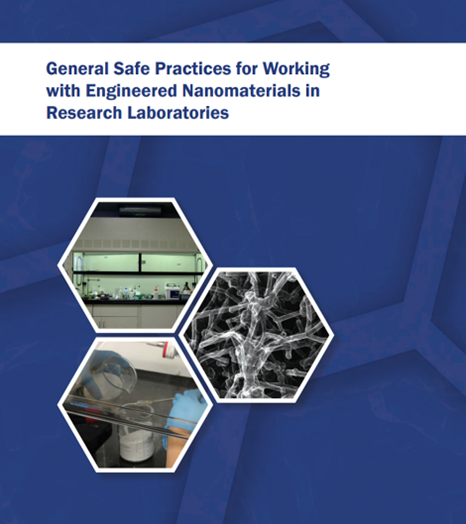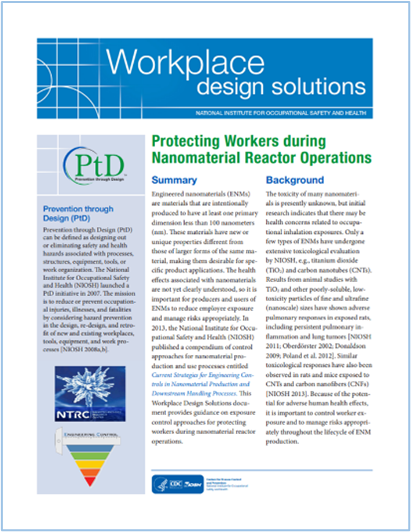Sweating the Small Stuff: 20 years of NIOSH Research on Engineering Controls for Nanotechnology
Posted on byEngineered nanomaterials are intentionally produced substances that have at least one primary dimension less than 100 nanometers (nm). Nanomaterials may have properties different from those of larger particles of the same material, making them unique and desirable for specific product applications (e.g., cosmetics, electronics, construction materials). The health effects associated with nanomaterials are not yet clearly understood, so it is important for producers and users of engineered nanomaterials to reduce employee exposure and manage risks appropriately.
The Nanotechnology Products Database lists over 11,000 nano-enabled products being manufactured in 68 different countries. With the proliferation of thousands of new materials, and occupational exposure limits for just a few, the use of engineering controls is a key part of protecting the workers that produce or use them. Engineering controls protect workers by removing hazardous conditions or placing a barrier between the worker and the hazard. Along with safe handling techniques, engineering controls are likely to be the most effective control strategy for nanomaterials. Identifying and adopting engineering control technologies that are effective in other industries is an important step in reducing worker exposures to engineered nanoparticles. Properly designing, using, and evaluating the effectiveness of these controls is a key component in reducing worker risk.

Protecting Workers
Since the creation of the NIOSH Nanotechnology Research Center (NTRC), engineers and industrial hygienists at NIOSH have conducted field studies to better understand how workers are exposed during the production and use of nanomaterials. Initially, these studies focused on carbon-based nanomaterials such as carbon nanotubes, nanofibers, and graphene. The studies helped researchers understand that nanomaterials behave in predictable ways like fine dusts and powders. This finding led to the recommendation of control approaches, such as those described below, based on extensive research on the pharmaceutical, coatings, and cosmetic industries.
In 2012, NIOSH published General Safe Practices for Working with Engineered Nanomaterials in Research Laboratories to help provide approaches to working with nanomaterials for the research community, which is at the front line of creating and using novel nanomaterials.
In 2013, NIOSH published the first engineering controls guidance document focused on common production processes, Current Strategies for Engineering Controls in Nanomaterial Production and Downstream Handling Processes. This document focused on the industrial environment and described common processes that had been shown by NIOSH and other investigators to result in worker exposures in the production and use of nanomaterials.
Following the publication of Current Strategies for Engineering Controls in Nanomaterial Production and Downstream Handling Processes, NIOSH developed short documents called Workplace Design Solutions to address the most common manufacturing processes. These short engineering control guidance documents include illustrations of controls along with performance criteria to allow companies or industrial hygiene consultants to identify commercially available technologies or to discuss the design with a qualified industrial ventilation firm. In addition, the three guidance documents provide summary information on control evaluation, preventative maintenance, worker training, and housekeeping:
- Protecting Workers during Nanomaterial Reactor Operations – this document provided engineering control recommendations for loading and unloading (or harvesting) and cleaning of small and large reactors such as those typically used for carbon nanotube production.
- Protecting Workers during the Handling of Nanomaterials – this document provided engineering control recommendations for handling of small quantities of nanomaterials using common ventilated enclosures such as chemical fume hoods, biological safety cabinets, ventilated balance enclosures and gloveboxes. The details on how to best use each of these controls and considerations for use are discussed.
- Protecting Workers during Intermediate and Downstream Processing of Nanomaterials –this document provided engineering control recommendations for ball milling, spray drying, thermoplastic extruding, filling, or emptying of product bags, and the use of downflow booths for larger scale material handling tasks.



What’s Next?
It’s really hard to tell. The engineering team learns from collaborations with companies to help solve worker exposure issues and find better ways to reduce potential adverse health effects from nanomaterials. The team works closely with their colleagues within the NTRC, including the Advanced Materials and Manufacturing Field Studies Team. NIOSH works with its partners to identify new nanomaterials in production and use, then develops innovative methods to control worker exposures. Over the next 20 years, the NTRC plans to seek out new industry partners. This continued collaboration will explore exposure challenges and develop cost-effective solutions to the variable landscape of nanomaterials.
This blog is part of a series to commemorate the 20th anniversary of the Nanotechnology Research Center. Click here for additional blogs in the series and on other nanotechnology topics.
Kevin H. Dunn, ScD, CIH, is a research mechanical engineer with the Engineering and Physical Hazards Branch in the NIOSH Division of Field Studies and Engineering.
Samuel Lo, PhD, is a research mechanical engineer with the Engineering and Physical Hazards Branch in the NIOSH Division of Field Studies and Engineering.
Jennifer Topmiller, MS, is the team leader of the Control Technology Team in the Engineering and Physical Hazards Branch in the NIOSH Division of Field Studies and Engineering.
Duane Hammond, MS, PE, is the team leader of the Engineering Design and Evaluation Team in the Engineering and Physical Hazards Branch in the NIOSH Division of Field Studies and Engineering.
Posted on by

